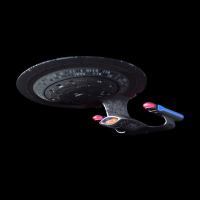

I’ll stand by the position that the Enterprise augment virus arc was an error, and the “explanation” for Klingon ridges is the same one you should use for the bridge of the Enterprise looking like it was cobbled together from plywood and plastic beads. This issue was best left to Worf’s lampshade in DS9 Trials & Tribleations.
It’s really interesting which visual differences humans will accept unthinkingly and which we will demand answers for. The Klingon ridges thing comes up constantly, but I have yet to see anyone earnestly ask why all the characters in Lower Decks have huge eyes and unnaturally uniform coloration, or why hand phaser beams in TOS go so much more slowly than later phasers and why everyone agrees to stay really still while they are being fired.




This one is a bit of a copout, because Kim’s official role as the ship’s operations officer would absolutely have been appropriate for a higher ranking officer. It’s the same job Data held as a Lieutenant Commander on the Enterprise; if anything, the strange bit is that it was given to a green ensign in the first place.
Ultimately, the real explanation is a much sillier bit of bad writing. According to Garret Wang, quoted here:
Why it was important that “somebody’s gotta be the ensign” is a mystery to me.